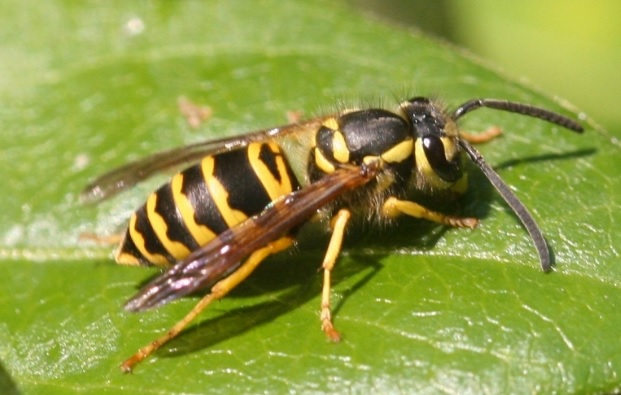Foraging Yellowjackets
ENTFACT-634: Foraging Yellowjackets | Download PDF
by Michael F. Potter, Extension Entomologist
University of Kentucky College of Agriculture
Yellowjackets are often considered the most dangerous stinging insects in the United States. They tend to be unpredictable and usually will sting if the nest is disturbed. During late summer and fall, yellowjacket colonies are nearing maturity and huge numbers of workers are out foraging for food for the developing queens.

Eastern Yellowjacket (Johnny N. Dell, Bugwood.org)
With insect prey (their usual diet) becoming scarce, yellowjackets scavenge for other sources of nutrition, especially sweets, e.g., fruits, ice cream, beer and soft drinks. The persistent foraging of yellowjackets at picnics and other outdoor activities produces many calls from homeowners and businesses wanting to know what can be done to alleviate the problem. Options include:
Sanitation
The best way to reduce the threat of foraging yellowjackets is to minimize attractive food sources. People eating outdoors should keep food and beverages covered until ready to be eaten. Spills and leftovers should be cleaned up promptly. Trash cans should be equipped with tight-fitting (preferably self- closing) lids. Similar sanitation recommendations should be made to commercial establishments, including ice cream parlors, outdoor cafes, and produce stands. Whenever possible, trash cans and dumpsters should be located away from serving tables, doors, and other high-traffic areas. Trash cans should be equipped with a plastic liner and emptied and cleaned frequently. Apples, pears, and other decomposing fruits falling from trees should be promptly raked up and discarded or buried.
Maintaining high levels of sanitation throughout the summer will make areas less attractive to yellow jackets later in the fall. This strategy is especially useful for parks and recreation areas.
Avoidance
Combined with sanitation, avoidance is the best advice in most situations. Yellowjackets foraging away from their nests are seldom aggressive and usually will not sting unless provoked. People should resist the temptation to "swat" at the wasps, and instead should carefully move away. Be especially careful when drinking from beverage cans which may contain foraging individuals. When yellowjackets are abundant, keep your thumb over the opening of the can between sips.
Avoidance may also be the best advice if a yellowjacket or hornet nest is located in a tree or other out-of-the-way location. Throughout Kentucky and much of the United States, yellowjacket colonies die off on their own in late autumn with the coming of cold weather. Abandoned nests are not reused and soon disintegrate.
Repellents
A dilute solution of ammonia and water (approximately 6 oz of ammonia per gallon of water) sprayed in and around trash cans and sponged onto outdoor tables and food preparation surfaces may help to repel yellowjackets from these areas. Use household ammonia, not Clorox (bleach).
Traps
Although only of marginal benefit, traps are available which catch impressive numbers of yellowjackets when properly baited and positioned (generally around the outer perimeter of the area you wish to protect). Business establishments such as outdoor cafes may find such traps worthwhile when used in conjunction with sanitation and other approaches. Cat food (canned), tuna, liverwurst, jelly, fruit juice, and other sweets are effective attractants. Yellowjacket traps are sold in some hardware and farm supply stores.
Insecticides
Elimination of yellowjackets is best accomplished by locating and destroying the nests. However, with foraging yellowjackets this is often impractical since the nest (or nests) may be located several hundred yards away. If the nest entrance can be located (typically underground in an old rodent burrow, beneath rocks or landscape timbers, or within a stone wall or wall of a building), it can often be eliminated by carefully applying a wasp aerosol insecticide into the nest opening. Insecticidal dust formulations, e.g., carbaryl (Sevin), bendiocarb (Ficam), Drione, etc., are especially effective provided a hand duster or similar type application device is used to dispense several puffs of the dust into the nest opening. A dry, empty liquid detergent bottle filled no more than halfway with dust and shaken before dispensing works fairly well in lieu of a commercial duster. A few pebbles or marbles added to the bottom of the bottle prevents the dust from caking.
Treatment should be performed late at night after all yellowjackets are in the nest and less active. Pinpoint the nest opening during the daytime, so you will remember where to direct your treatment after dark. Approach the nest slowly and do not shine the beam of your flashlight directly into the nest entrance as this may startle the wasps; instead, cast the beam to the side to illuminate the nest indirectly. If possible, place the light on the ground rather than in your hand. As with hornets, yellow jackets are extremely aggressive when the nest is disturbed. It may be prudent to call a professional pest control firm, particularly when access to the nest is difficult.
Allergic Reactions
Wasp, hornet and yellowjacket stings can be life-threatening to persons who are allergic to the venom. People who develop hives, difficulty breathing or swallowing, wheezing, or similar symptoms of allergic reaction should seek medical attention immediately. Itching, pain and localized swelling can be somewhat reduced with antihistamines and an ice pack.
Revised: 10/96
CAUTION! Pesticide recommendations in this publication are registered for use in Kentucky, USA ONLY! The use of some products may not be legal in your state or country. Please check with your local county agent or regulatory official before using any pesticide mentioned in this publication.
Of course, ALWAYS READ AND FOLLOW LABEL DIRECTIONS FOR SAFE USE OF ANY PESTICIDE!
Photo: University of Florida
